Operations on Decimal Numbers
Column Addition and Subtraction
Method Column addition and subtraction
- Line up the decimal points vertically. Fill in any zeros where necessary.
- Add or subtract the numbers as if they were whole numbers.
- Place the decimal point in the sum or difference so that it lines up vertically with the numbers being added or subtracted.
Example
Calculate \(3.83 + 2.7\).
- Line up the decimal points vertically and fill in zeros where necessary:
- Add the hundredths digits: \(\textcolor{colordef}{3} + \textcolor{colordef}{0} = \textcolor{colorprop}{3}\)
- Add the tenths digits: \(\textcolor{colordef}{8} + \textcolor{colordef}{7} = \textcolor{olive}{\scriptstyle 1} \textcolor{colorprop}{5}\), carry \(\textcolor{olive}{\scriptstyle 1}\)
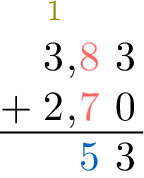
- Add the ones digits: \(\textcolor{colordef}{1 \text{(carry)}} + \textcolor{colordef}{3} + \textcolor{colordef}{2} = \textcolor{colorprop}{6}\)
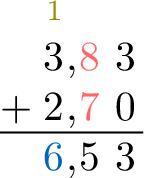
- So, \(3.83 + 2.7 = 6.53\)
Example
Calculate \(3.8 - 2.9\).
- Line up the decimal points vertically and fill in any zeros where necessary:
- Subtract the tenths digits: \(\textcolor{olive}{\scriptstyle 1}\textcolor{colordef}{8} - \textcolor{colordef}{9} = \textcolor{colorprop}{9}\), with \(\textcolor{olive}{\scriptstyle 1}\) borrowed.
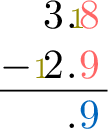
- Subtract the ones digits: \(\textcolor{colordef}{3} - \textcolor{colordef}{1 \text{ (borrow)}} - \textcolor{colordef}{2} = \textcolor{colorprop}{0}\)
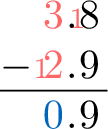
- So, \(3.8 - 2.9 = 0.9\)
Column Multiplication
Method Column multiplication
- Multiply the decimals as if the decimals were whole numbers.
- The number of decimal places in the product is the sum of the number of decimal places in each factor.
Example
Calculate \(3.48 \times 2.9\).
- Set up the column multiplication:
- Multiply the bottom tenth digit: \(\textcolor{colordef}{348} \times \textcolor{colordef}{9} = \textcolor{colorprop}{3132}\)
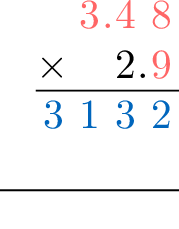
- Multiply the bottom one digit: \(\textcolor{colordef}{348} \times \textcolor{colordef}{2} = \textcolor{colorprop}{696}\).
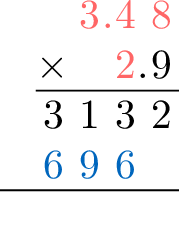
- Add the results: \(\textcolor{colordef}{3132} + \textcolor{colordef}{6960} = \textcolor{colorprop}{10092}\)

- So, \(3.48 \times 2.9 = 10.092\) with 3 decimal places.
Long Division
Method Long Division by a Whole Number
When the divisor is a whole number, follow these steps:
- Place the Decimal Point: Align the decimal point in the quotient directly above the decimal point in the dividend.
- Divide as Whole Numbers: Perform the division as if both the dividend and divisor are whole numbers.
- Bring Down Digits: Starting from the left of the dividend, bring down digits one at a time to continue the division process.
- Handle Decimal Places: When you reach the decimal point in the dividend, place the decimal point in the quotient and continue dividing by bringing down the digits after the decimal point (tenths, hundredths, etc.).
Example
Calculate \(34.4 \div 4\).
- Set up the long division:

- Place the decimal point: Align the decimal point in the quotient directly above the decimal point in the dividend.
Check how many times 4 fits into 34:- \(8 \times 4 = 32 \leq 34\)
- \(9 \times 4 = 36 > 34\)
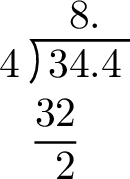
- Continue the division:
- Subtract \(32\) from \(34\) to get a remainder of \(2\).
- Bring down the next digit (4) to make \(24\).
- Check how many times 4 fits into 24: \(6 \times 4 = 24\)
- So, 4 fits into 24 6 times.
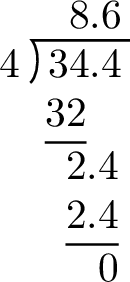
- Final result:
- The remainder is \(0\), so the division is complete.
- Therefore, \(34.4 \div 4 = 8.6\).